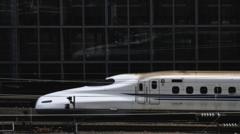In just six hours, Japan completed the world's first 3D-printed train station, a project aimed to enhance rail accessibility in small towns amid a changing demographic landscape.
**Japan's 3D-Printed Train Station Revolutionizes Rail Infrastructure**

**Japan's 3D-Printed Train Station Revolutionizes Rail Infrastructure**
A landmark achievement in rapid construction technology showcases Japan's innovative response to rural rail service challenges.
In an extraordinary feat of engineering, workers have erected a new train station in rural Japan overnight, a project that highlights the nation's response to dwindling populations in small towns and the pressing need for efficient infrastructure. The Hatsushima station, located in Arida, was 3D-printed at a factory prior to being assembled in a record six hours, revolutionizing traditional construction methods that often require months to complete.
Built to replace a wooden structure that had served the community for over 75 years, the Hatsushima station is a significant example of how innovative building technologies can address challenges in maintaining rail services. According to the West Japan Railway Company, constructing the station via conventional methods would have taken over two months and cost twice as much.
As Japan faces a rapidly aging population and a decreasing workforce, railway operators are increasingly pressed to maintain infrastructure with diminishing ridership in rural areas. The Hatsushima station serves approximately 530 passengers daily on a line that connects with larger urban centers like Osaka and Nara, attracting both commuters and tourists alike.
Local residents, including regular users like 19-year-old Yui Nishino, have expressed enthusiastic approval for the new station. Nishino, who relies on the train for her daily commute to university, remarked on the astonishing speed of construction and shared her hope that 3D printing technology could be utilized for future building projects.
The launch of the Hatsushima station marks a pivotal moment for Japan's rail services and showcases the potential for 3D printing to redefine transportation infrastructure globally. As communities grapple with the realities of demographic changes, this pioneering approach may provide the necessary solutions to sustain critical transport links in rural areas.
Built to replace a wooden structure that had served the community for over 75 years, the Hatsushima station is a significant example of how innovative building technologies can address challenges in maintaining rail services. According to the West Japan Railway Company, constructing the station via conventional methods would have taken over two months and cost twice as much.
As Japan faces a rapidly aging population and a decreasing workforce, railway operators are increasingly pressed to maintain infrastructure with diminishing ridership in rural areas. The Hatsushima station serves approximately 530 passengers daily on a line that connects with larger urban centers like Osaka and Nara, attracting both commuters and tourists alike.
Local residents, including regular users like 19-year-old Yui Nishino, have expressed enthusiastic approval for the new station. Nishino, who relies on the train for her daily commute to university, remarked on the astonishing speed of construction and shared her hope that 3D printing technology could be utilized for future building projects.
The launch of the Hatsushima station marks a pivotal moment for Japan's rail services and showcases the potential for 3D printing to redefine transportation infrastructure globally. As communities grapple with the realities of demographic changes, this pioneering approach may provide the necessary solutions to sustain critical transport links in rural areas.





















